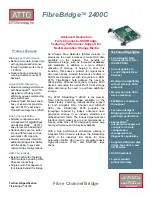
76
Brocade Adapters Troubleshooting Guide
53-1001582-01
Diagnostics
3
Performing Ethernet loopback tests through BCU
Use the ethdiag --loopback command to run an Ethernet loopback test.
bcu ethdiag --loopback <port_id> [-t <loopback_type] [-c <frame_count>] [-p
pattern]
where:
port_id
ID of the port for which you want to run the test. This could be the PWWN, port
hardware path, or user-specified port name. This could also be the
adapter-index/port-index. For example, to specify adapter 1, port 1 you would
use 1/1 as the port identification.
-t loopback-type
Specifies the loopback type. Possible values are serdes, and ext.
-c frame count
Specifies the frame count.
-p pattern
Specifies the pattern (must be one hex word).
NOTE
You must disable the port before running a loopback test. Use BCU port --disable <port_ID>
command.
PCI loopback test
Use BCU commands or HCM to perform a PCI loopback test for a specific port. In this test, a data
pattern is sent from the host to adapter firmware through the PCI bus. The returned data is
validated to determine PCI operation.
NOTE
You must disable the port before you run loopback tests.
Performing PCI loopback tests through BCU
Use the diag --pciloopback BCU command to perform a PCI loopback test.
diag --pciloopback <port_id> [-p <pattern>] [-c <frame_count>]
where:
port_id
ID of the port from which you want to run the test. This could be the PWWN,
port hardware path, or user-specified port name. This could also be the
adapter-index/port-index. For example, to specify adapter 1, port 1, you would
use 1/1 as the port identification.
pattern
Specifies the data test pattern. Must be at least one hexadecimal word.
frame count
Specifies the frame count as an integer from 0 to 4,294,967,295.
Performing PCI loopback tests through HCM
Use the Hardware Tests tab on the Diagnostics dialog box to perform a PCI loopback test as follows.
1. Launch the HCM.
2. Select Configure > Diagnostics.
















































